A New Spectral-Homotopy Perturbation Method and Its Application to Jeffery-Hamel Nanofluid Flow with High Magnetic Field
Abstract
We present a new modification of the homotopy perturbation method (HPM) for solving nonlinear boundary value problems. The technique is based on the standard homotopy perturbation method, and blending of the Chebyshev pseudospectral methods. The implementation of the new approach is demonstrated by solving the Jeffery-Hamel flow considering the effects of magnetic field and nanoparticle. Comparisons are made between the proposed technique, the standard homotopy perturbation method, and the numerical solutions to demonstrate the applicability, validity, and high accuracy of the present approach. The results demonstrate that the new modification is more efficient and converges faster than the standard homotopy perturbation method.
1. Introduction
Many problems in the fields of physics, engineering, and biology are modeled by coupled linear or nonlinear systems of partial or ordinary differential equations. Compared to nonlinear equations, linear equations can be easily solved and finding analytical solutions to nonlinear problems on finite or infinite domains is one of the most challenging problems. Such problems do not usually admit closed from analytic solutions and in most cases we look for finding approximate solutions using numerical approximation techniques. Nonnumerical approaches include the classical power-series method and its variants for systems of nonlinear differential equations with small or large embedded parameters. One of these methods is the homotopy perturbation method (HPM). This method, which is a combination of homotopy in topology and classic perturbation techniques, provides us with a convenient way to obtain analytic or approximate solutions for a wide variety of problems arising in different scientific fields by continuously deforming the difficult problem into a set of simple linear problems that are easy to solve. It was proposed first by He [1–4]. He has successfully used the method to solve many types of linear and nonlinear differential equations such as Lighthill equation [1], Duffing equation [2], Blasius equation [5], wave equations [4], and boundary value problems [6]. Homotopy perturbation method has been recently intensively studied by many authors and they used the method for solving nonlinear problems and some modifications of this method have been published [7–12] to facilitate, make accurate calculations, and accelerate the rapid convergence of the series solution and reduce the size of work. Jalaal et al. [13] used HPM to investigate the acceleration motion of a vertically falling spherical particle in incompressible Newtonian media. Jalaal and Ganji [14] applied HPM successfully on the problem of unsteady rolling motion of spheres in inclined tubes filled with incompressible Newtonian fluids. They found that the inclination angle does not affect the acceleration duration.
The application of the homotopy perturbation method in linear and non-linear models has been developed by many scientists and engineers, because this method provides us with a convenient way to obtain analytic or approximate solutions for a wide variety of problems arising in different scientific fields by continuously deforming the difficult problem into a set of simple linear problems that are easy to solve (e.g., see [12, 15, 16]).
The homotopy perturbation method has been applied on the MHD Jeffery-Hamel problem by [17]. This model is one of the most applicable cases of the incompressible viscous fluid flow through convergent-divergent channels in fluid mechanics, civil, environmental, mechanical, and bio-mechanical engineering. Jeffery [18] and Hamel [19] were the first persons who discussed this case, and so it is known as Jeffery-Hamel problem. They presented an exact similarity solution of the Navier-Stokes equations in the special case of two-dimensional flow through a channel with inclined plane walls meeting at a vertex and with a source or sink at the vertex. The problem has been well extensively studied by several authors and discussed in many articles and textbooks. The study of [20] considers the steady two-dimensional radial flow of viscous fluid between plane walls which either converge or diverge. In the Ph.D. thesis [21], we find that Jeffery-Hamel flow is used as asymptotic boundary conditions to examine steady two-dimensional flow of a viscous fluid in a channel. But, here, certain symmetric solutions of the flow have been considered, although asymmetric solutions are both possible and of physical interest [22]. The classical Jeffery-Hamel problem was extended in [23] to include the effects of an external magnetic field on an electrically conducting fluid. Recent studies to solving the Jeffery-Hamel flow problem include perturbation techniques [24], Adomian decomposition method [25–27], homotopy analysis method [28–30], optimal homotopy asymptotic method [31], and variational iteration method [17].
In this work, we present an alternative and improved form of the HPM called spectral-homotopy perturbation method (SHPM) that blends the traditional homotopy perturbation method with the Chebyshev spectral collocation method. The advantage of this approach is that it is more flexible than HPM for choosing a linear operator and initial guess. In HPM, one is restricted to choosing a linear operator and initial approximation that would make the integration of the higher-order differential equations possible whereas the SHPM allows us to have a wider range of selecting linear operators and an initial guess may be used as long as it satisfies the boundary conditions.
We have applied the new technique to find an approximate solution of MHD Jeffery-Hamel flow and to study the effect of nanoparticle volume fraction on the velocity profile. We have made a comparison between the current results and the numerical solutions in plots and tables to show the applicability, validity, and accuracy of this method. The obtained results give rapid convergence, good accuracy and suggest that this newly improvement technique introduces power for solving nonlinear boundary value problems and several advantages of the SHPM over the HPM approach are also pointed out.
2. Mathematical Formulation
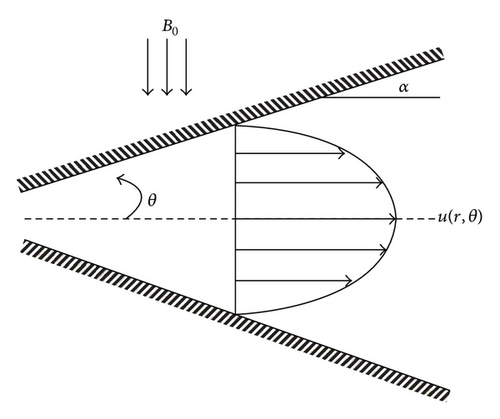
3. Homotopy Perturbation Method
4. Spectral-Homotopy Perturbation Method
- (1)
linearize the non-linear differential equation by applying HPM,
- (2)
rewrite the resulting linear differential equation in a system of linear equations using Chebyshev pseudospectral collocation method,
- (3)
solve the system of equations to get the solution of origin differential equation.
- (i)
the second derivative of N(v) with respect to v must be small because the parameter p may be relatively large; that is, p → 1;
- (ii)
the norm of L−1(∂N/∂v) must be smaller than one so that the series converges.
Here, we observe that the main difference between HPM and SHPM is that the solutions are obtained by solving a system of higher-order ordinary differential equations in the HPM while for the SHPM solutions are obtained by solving a system of linear algebraic equations of the form (42) that are easier to solve.
5. Results and Discussion
In this section, we present the results obtained using the SHPM and the numerical solution for MHD Jeffery-Hame, flow with nanoparticle. Here, we used the inbuilt MATLAB boundary value problem solver bvp4c for the numerical solution approach. In generating the presented results, it was determined through numerical experimentation that N = 80 and we considered the fourth-order of SHPM which gave sufficient accuracy for the method. In this study, copper (Cu) is considered as nanoparticles with water being as the base fluid and we assumed that the base fluid and the nanoparticles are in thermal equilibrium and no slip occurs between them. The density of water is ρf = 997.1 and the density of Cu is ρs = 8933.
Figures 2 and 3 show, firstly, the influence of the various physical parameters on the velocity profiles and, secondly, a comparison between the present results and numerical results to give a sense of the accuracy and convergence rate of the SHPM. The figures show that there is very good match between the two sets of results even at very low orders of SHPM approximations series compared with the numerical results. These findings firmly establish SHPM as an accurate alternative to HPM. Table 1 gives a comparison of SHPM results at 2nd and 3rd orders of approximation against the numerical results for fixed values of Re = 10, Ha = 200, and α = 5 when η and ϕ are varied. It can be seen, from Table 1, that SHPM results converge rapidly to the numerical solution and similar results achieved between the numerical results and 3rd order of SHPM approximation up to 8 decimal places. Table 2 shows a comparison of HPM and SHPM results at different orders of approximation against the numerical results at selected values of magnetic field and nanoparticle volume fraction for fixed values of Re and α. Convergence of the SHPM is achieved at the 2nd order of approximation up to 8 decimal places as observed in Table 2 even for large values of Ha. In Table 3, we made a comparison between the numerical results, HPM, 10th-order homotopy analysis method [32], and variational iteration method [17] and different order of SHPM of the fluid velocity F(η) and the second derivative F′′(η). The convergence of the SHPM is achieved at the 4th order whereas convergence is not achieved even at the 10th order of HAM approximation. Clearly, SHPM converges at least four times as fast and demonstrates the higher accuracy than HAM, HPM, and VIM. For this reason, SHPM has been used to investigate the effects of physical parameters of the problem. The effect of the magnetic field on the velocity profile is displayed in Figures 2(a) and 2(b) of convergent and divergent channels for fixed values of nanoparticle volume fraction and fixed Reynolds number. The figures indicate that the increase in the Hartmann number leads to increase in the velocity profiles for both convergent and divergent channels which has a great effect on the performance of the system. This is due to the fact that the variation of Ha leads to the variation of the Lorentz force due to the magnetic field, and the Lorentz force produces more resistance to the transport phenomena. Similar result has been reported by [26, 27, 32]. Figure 3 shows the effect of nanoparticle volume fraction on the fluid velocity for fixed Hartmann and Reynolds numbers. It is observed that the fluid velocity increases with the increase in the value of ϕ in the case of diverging channels, and backflow phenomenon is expected for small values of ϕ and large values of Re, while the fluid velocity decreases as the nanoparticle volume fraction increases for the converging channels case. Figure 4 illustrates the effect of increasing Reynolds numbers on the fluid velocity. It was found that, from Figures 4(a) and 4(b) for inflow system, back flow is prevented in the case of convergent channels but is possible for large Reynolds numbers in the case of divergent channels; that is, there is a reverse condition for outflow regime (see [17, 32]).
| η | F(η) | F′′(η) | |||||
|---|---|---|---|---|---|---|---|
| 2nd order | 3rd order | Numerical | 2nd order | 3rd order | Numerical | ||
| ϕ = 0.1 | 0.0 | 1 | 1 | 1 | −1.97361423 | −1.97361423 | −1.97361423 |
| 0.1 | 0.99013256 | 0.99013258 | 0.99013258 | −1.97286367 | −1.97286367 | −1.97286367 | |
| 0.2 | 0.96053716 | 0.96053725 | 0.96053725 | −1.97132614 | −1.97132614 | −1.97132614 | |
| 0.3 | 0.91122738 | 0.91122758 | 0.91122758 | −1.97114172 | −1.97114171 | −1.97114172 | |
| 0.4 | 0.84220211 | 0.84220246 | 0.84220246 | −1.97587434 | −1.97587434 | −1.97587434 | |
| 0.5 | 0.75340988 | 0.75341039 | 0.75341039 | −1.99052431 | −1.99052431 | −1.99052431 | |
| 0.6 | 0.64469883 | 0.64469947 | 0.64469947 | −2.02157959 | −2.02157959 | −2.02157959 | |
| 0.7 | 0.51575172 | 0.51575242 | 0.51575242 | −2.07714031 | −2.07714032 | −2.07714032 | |
| 0.8 | 0.36600474 | 0.36600533 | 0.36600533 | −2.16716308 | −2.16716309 | −2.16716309 | |
| 0.9 | 0.19454749 | 0.19454782 | 0.19454782 | −2.30388760 | −2.30388760 | −2.30388760 | |
| 1.0 | 0 | 0 | 0 | −2.50253230 | −2.50253230 | −2.50253230 | |
| ϕ = 0.4 | 0.0 | 1 | 1 | 1 | −1.97636754 | −1.97636754 | −1.97636754 |
| 0.1 | 0.99011749 | 0.99011749 | 0.99011749 | −1.97717852 | −1.97717852 | −1.97717852 | |
| 0.2 | 0.96046170 | 0.96046171 | 0.96046171 | −1.97979610 | −1.97979610 | −1.97979610 | |
| 0.3 | 0.91100600 | 0.91100602 | 0.91100602 | −1.98477509 | −1.98477509 | −1.98477509 | |
| 0.4 | 0.84169981 | 0.84169985 | 0.84169985 | −1.99304375 | −1.99304375 | −1.99304375 | |
| 0.5 | 0.75245937 | 0.75245942 | 0.75245942 | −2.00591025 | −2.00591025 | −2.00591025 | |
| 0.6 | 0.64315460 | 0.64315467 | 0.64315467 | −2.02507402 | −2.02507402 | −2.02507403 | |
| 0.7 | 0.51359211 | 0.51359218 | 0.51359218 | −2.05264442 | −2.05264442 | −2.05264442 | |
| 0.8 | 0.36349409 | 0.36349415 | 0.36349415 | −2.09116967 | −2.09116967 | −2.09116968 | |
| 0.9 | 0.19247275 | 0.19247278 | 0.19247278 | −2.14368045 | −2.14368045 | −2.14368046 | |
| 1.0 | 0 | 0 | 0 | −2.21375299 | −2.21375298 | −2.21375298 | |
| ϕ | Ha | SHPM | HPM | Numerical | |||
|---|---|---|---|---|---|---|---|
| 1st order | 2nd order | 3rd order | 4th order | ||||
| 0 | 0 | −2.25205783 | −2.25205817 | −2.25205817 | −2.25205817 | −2.2522802 | −2.25205817 |
| 50 | −2.18134736 | −2.18134748 | −2.18134748 | −2.18134748 | −2.1795097 | −2.18134748 | |
| 100 | −2.11325918 | −2.11325920 | −2.11325920 | −2.11325920 | −2.1107698 | −2.11325920 | |
| 500 | −1.65047007 | −1.65046878 | −1.65046877 | −1.65046877 | −1.6734400 | −1.65046877 | |
| 0.05 | 0 | −2.21083280 | −2.21083294 | −2.21083294 | −2.21083294 | −2.2110158 | −2.21083294 |
| 50 | −2.14969149 | −2.14969153 | −2.14969153 | −2.14969153 | −2.1484672 | −2.14969153 | |
| 100 | −2.09055197 | −2.09055197 | −2.09055197 | −2.09055197 | −2.0889107 | −2.09055197 | |
| 500 | −1.68097975 | −1.68097904 | −1.68097904 | −1.68097904 | −1.6988408 | −1.68097904 | |
| 0.1 | 0 | −2.17511715 | −2.17511720 | −2.17511720 | −2.17511720 | −2.1752670 | −2.17511720 |
| 50 | −2.12250597 | −2.12250599 | −2.12250599 | −2.12250599 | −2.1217211 | −2.12250599 | |
| 100 | −2.07140445 | −2.07140446 | −2.07140446 | −2.07140446 | −2.0703633 | −2.07140446 | |
| 500 | −1.71124187 | −1.71124151 | −1.71124151 | −1.71124151 | −1.7246699 | −1.71124151 | |
| η | HPM | Reference [32] | Reference [17] | SHPM | Numerical | |||
|---|---|---|---|---|---|---|---|---|
| 2nd order | 3rd order | 4th order | ||||||
| F(η) | 0 | 1 | 1 | 1 | 1 | 1 | 1 | 1 |
| 0.25 | 0.894960 | 0.894242 | 0.894243 | 0.894238 | 0.894242 | 0.894242 | 0.894242 | |
| 0.50 | 0.627220 | 0.626948 | 0.626953 | 0.626937 | 0.626948 | 0.626948 | 0.626948 | |
| 0.75 | 0.302001 | 0.301991 | 0.301998 | 0.301982 | 0.301990 | 0.301990 | 0.301990 | |
| 1 | 0 | 0 | 0 | 0 | 0 | 0 | 0 | |
| F′′(η) | 0 | −3.539214 | −3.539417 | −3.539369 | −3.539546 | −3.539416 | −3.539416 | −3.539416 |
| 0.25 | −2.661930 | −2.662083 | −2.662048 | −2.662153 | −2.662084 | −2.662084 | −2.662084 | |
| 0.50 | −0.879711 | −0.879791 | −0.879791 | −0.879612 | −0.879793 | −0.879794 | −0.879794 | |
| 0.75 | −0.447331 | 0.447242 | 0.447052 | 0.447350 | 0.447244 | 0.447244 | 0.447244 | |
| 1 | −0.854544 | 0.854367 | 0.854440 | 0.854239 | 0.854369 | 0.854369 | 0.854369 | |
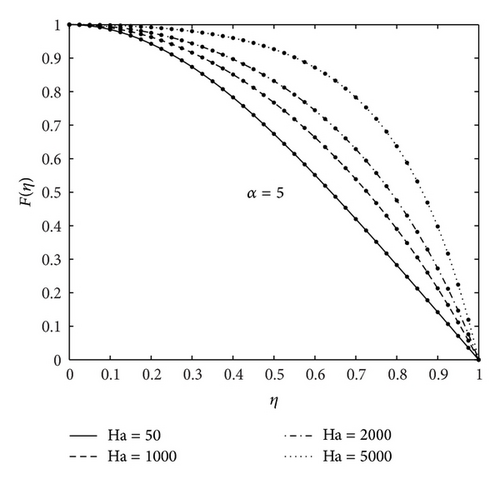
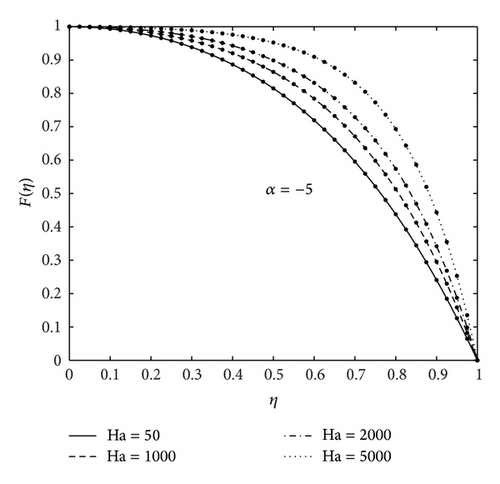
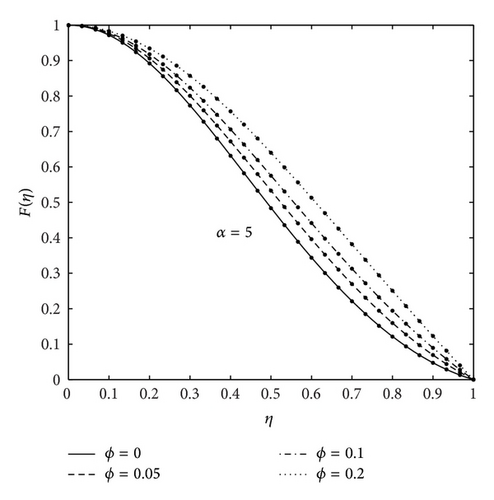
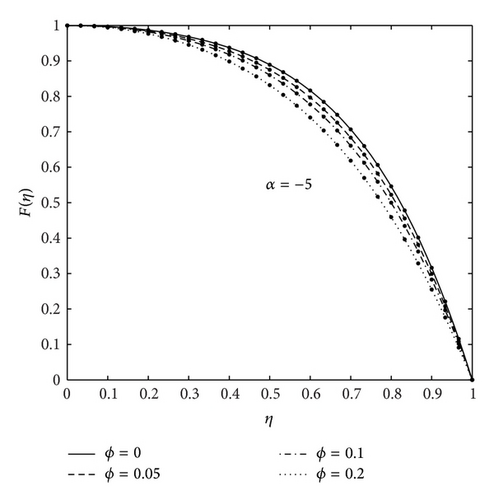
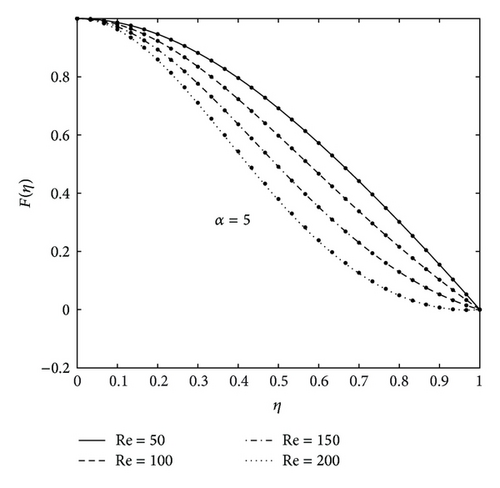
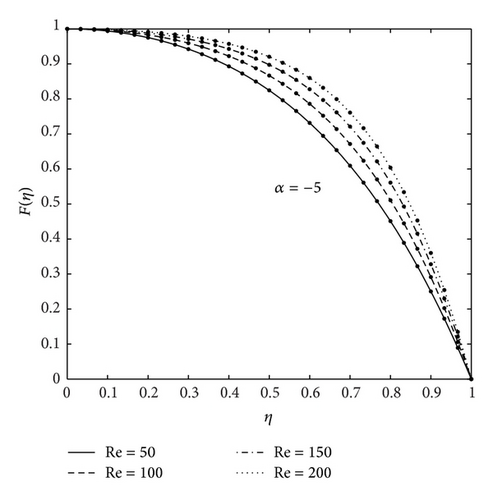
6. Conclusion
In this work, we have proposed a modification of the standard homotopy perturbation method for solving nonlinear ordinary differential equations. The method has been used to solve the 3rd-order MHD Jeffery-Hamel flow with nanoparticle. Tables and graphical results are presented to show the accuracy and the convergence rate of the SHPM and to investigate the effects of different physical parameters on the flow as well.
- (1)
SHPM is highly accurate, efficient and converges rapidly with a few iterations required to achieve the accuracy of the numerical results compared with the standard HPM. For example, in this study, it was found that only fourth iteration of SHPM was sufficient to give good agreement with the numerical results.
- (2)
The method proposes a standard way of choosing the linear operators and initial approximations by using any form of initial guess as long as it satisfies the boundary conditions while the initial guess in the HPM can be selected that will make the integration of the higher-order deformation equations possible.
- (3)
The SHPM converges much faster than HPM. For example, in the study above, it was found that the third-order SHPM approximation was sufficient to give good agreement with the numerical results.
- (4)
The increase of volume fraction causes an increase in the fluid velocity profile for of diverging channels while the velocity decreases for the converging channels case.
- (5)
The fluid velocity increases with increasing Hartman numbers for both diverging and converging channels cases.




